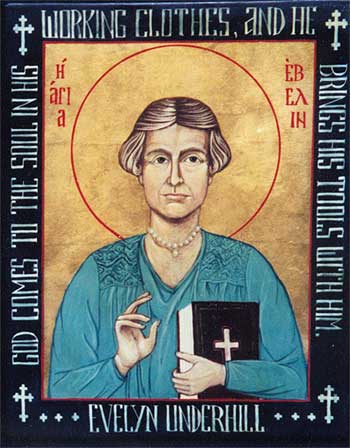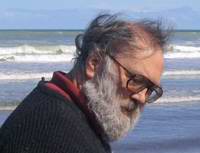The Essential Evelyn Underhill

Evelyn Underhill is arguably one of the greatest of twentieth century mystics. She died in 1941, a convinced pacifist, and consequently, in the light and shadows cast by World War II, her writing was largely ignored for the next thirty or forty years. When it found a new audience it was, ironically, her early work that spoke most strongly to a generation largely distrustful of institutionalised religion and inclined to see spirituality as a personal matter. Her later work, drawing ever more deeply on her growing appreciation of the role of the Church in personal faith, has tended to be the preserve of specialists.
She began with a profound spiritual experience, bedded originally in agnosticism and she initially sought a context for it in the Order of the Golden Dawn, and was attracted to the teaching of A.E. Waite and others. It is possible that this early experience fuelled much of the later contempt and scorn and invective that she was to heap on the Quietists, the pantheists, the theosophists, the "amateur" mystics, at every opportunity throughout her writings on mysticism.
Much of her early understanding, too, was founded on the vitalist theories of Henri Bergson which by the time of the revised 12th edition of Mysticism in 1933, she felt obliged to discard. She continued to seek, however, for a philosophical basis for the process of incarnation that she understood to be God manifest in and throughout His creation. Again, this spoke to a "New Age" generation seeking an alternative to the spiritual barrenness of the dominant naturalist philosophies which, if they could not disprove God's existence, rendered Him increasingly irrelevant.
She was deeply attracted for a period to Catholicism, but found the papal strictures against philosophical "Modernism" ultimately unacceptable to her fiercely independent and highly competent intellect, and eventually found her long term home in the Anglican Church.
Mysticism, the work for which she remains best known, depicts mystical experience as a direct and immediate personal experience of God, something different from and often outnumbered or hidden by "the more obvious qualities of the superstitious and the ecclesiastically minded". The mystics, she said, are the true Christians, the surrendered "little flock" who are the ongoing—and only—source of spiritual vitality among Church members.
The beginning of Christianity, we say, seems to represent the first definite emergence of a new kind of life; at first ... a small beginning. Very, very slowly, the new type of human consciousness emerged. Here one, and there another possessed: the thin bright chain of Christian mystics stretching across the centuries. We see clearly, when we have cleansed our vision of obscuring prejudices, that Jesus, from the moment of His attainment of full spiritual consciousness, was aware that life must act thus....
But such a gift can only gradually be disclosed, only gradually be appropriated. Those who can appropriate, who can move in this fresh direction, grow to this state of high tension, develop this spiritual consciousness — these are the "little flock" to whom the Kingdom, the Realm of Reality is given. These, not the strenuous altruist nor the orthodox believer, are the few chosen out of the many called; actual centres of creative life, agents of divine fecundity, the light, the salt, the leaven, the pathfinders of the race. It is the glory of Christianity that, hidden though they be by the more obvious qualities of the superstitious and the ecclesiastically minded, these vital souls have never failed the Church. Thus, "by personal channels — the flame of the human and humanising Spirit passing from soul to soul — there has come down to our days, along with a great mass of nominal or corrupt Christianity, a true and lineal offspring of the Church established on the Rock."
Evelyn Underhill: The Mystic Way, p. 43 - 44
|
When you consider the enormity of this message, when you consider the magnitude of what is implied, and when you appreciate that it was made from within the Anglican Church, in the early years of the 20th century, and made with calm authority by a woman, and moreover, the first woman accepted by the Anglican Church to train its clergy, you may come to see why I think this is perhaps a woman to die for.
That said, there are also some aspects of her thought that I take issue with, and the works on this website contain, from time to time, in blue font or in blue boxes, my 'pencil notes in the margin'. If you wish to make personal copies from the works on this website it is a simple matter to isolate and remove these notes from the text proper.
Many of the works on this site are available elsewhere on the internet, but often in deeply flawed, badly scanned, or incomplete editions that are nearly impossible to read with any degree of comfort. I have in these cases done whatever I can to provide a better alternative.
DCW
|
1906 - The Miracles of Our Lady Saint Mary
1911 - Mysticism
1912 - Introduction to The Cloud of Unknowing
1913 - The Mystic Way
1914 - Introduction: Richard Rolle - The Fire of Love
1915 - Practical Mysticism
1915 - Introduction: Songs of Kabir
1916 - Introduction: John of Ruysbroeck
1920 - The Essentials of Mysticism, and other Essays
1922 - The Spiral Way
1922 - The Life of the Spirit and the Life of Today (Upton Lectures)
1926 - Concerning the Inner Life
1928 - Man and the Supernatural
1929 - The House of the Soul
1933 - The Golden Sequence
1933 - Mixed Pasture: Twelve Essays
1936 - The Spiritual Life
1943 - Introduction to the Letters of Evelyn Underhill
by Charles Williams
COPYRIGHT
As far as I have been able to ascertain, all of these works are now in the public domain. If you own copyright in any of these, please let me know immediately and I shall either negotiate permission to use them or remove them from the site as appropriate.
DCW
|



